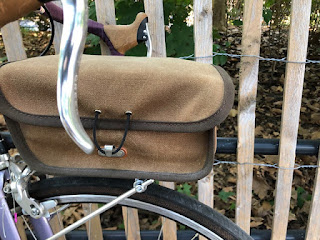Some would argue that a true artist, or even artisan, wants the focus to be on his or her work rather than him or her self. They may have a point: After all, while some (yes, I include myself) might be interested in the details of Rodin's, Picasso's, Shakespeare's, Louis Armstrong's or Georgia O'Keefe's personal lives, what matters is the images, sounds and words they left us.
So I could understand Ron's wish not disclose his wife's name, or even his last name. For the past fifteen years, they've done work that has, rightly, attracted attention in the cycling word--and outside of it.
One day this past fall, when I was crossing underneath the Hudson on the PATH train with Dee-Lilah, my custom 2018 Mercian Vincitore Special, two young couples asked me about the bike, with its lovely (if I do say so myself) paint finish, intricate lug work and a couple of nicely-made bags--or, if you prefer, pieces of bicycle luggage.
A male member of one couple, and a female of the other, seemed to be regular cyclists and wanted to know about the bike itself. But the male member of the other couple--who told me he rides, but is "not a bike fanatic"--was interested in the bags because, he said, he's thinking of leaving his regular job and becoming a full-time maker of custom bags of all kinds. He could see the workmanship on the bike's bag, he said, and was curious as to who makes such items.
A couple of weeks ago, when I pulled into a service station/convenience store on Point Lookout with Zebbie, my 1984 Mercian King of Mercia, someone asked about both the bike--which, while its lugwork isn't as intricate as Dee-Lilah's, has a unique paint job--and the bags I'd attached to it.
In both instances, folks were curious about bags, or bicycle luggage, made by Acorn Bags in California. I've been using them (along with Ruthworks Bags, which I've mentioned in previous posts) for about three years. They haven't quite developed the "patina" canvas bags like it acquire because, since I have several bikes (and a bunch of bags), there isn't one, or even a set, that I use every day. But I feel I've ridden the Acorn bags enough to comment on them.
First of all, I want to say that while they might seem expensive in comparison to mass-produced bags of synthetic materials, Acorn's prices are actually quite reasonable, especially when you consider the materials used and the hand work that goes into making them.
More important, the materials and workmanship on them are impeccable. The canvas is as strong as it is aesthetically pleasing, and the stitching is consistent and formidable. Currently, Acorn's bags are made in three colors: black, gray and brown. Every couple of months, Acorn makes a run of bags in one of those colors. They post a list of colors and anticipated availability dates on their website, so if you have your heart set on a particular color or model, sign up for their mailing list.
While I like all of their colors, my particular preference is for brown. It looks both earthy and classy, like a leather bag or pair of boots made in a similar color. Also, it's similar to a color in which Specialites TA-LaFuma bags were made for several years.
I've been using their medium randonneur bag, front "bread box" bag and two of their saddle bags. With the exception of their "bread box" bag, all are inspired by classic French and English designs. It's hard not to notice the similarities between the Medium Rando bag on the front rack of Zebbie and its Specialites TA counterpart, the Medium saddlebag on that bike and the Berthoud "banana" bag, or the saddlebag on Dee-Lilah and some Carradice or Brooks designs.
But Ron and his wife don't seem content to copy traditional designs as much as possible. They seem to have thought of how those beautiful, durable bags can be made more convenient. For example, the Medium Rando bag can be used, with light loads, without a decaleur as long as you mount it on a rack like the Nitto M12 or M18 or Velo Orange racks with the "tombstone." (The "bread box" bag is also designed to be ridden with such racks.) With somewhat heavier loads, you might want the decaleur, but I've managed to stabilize the bag with a small bungee cord attached hooked onto the D ring on either side and passed underneath the rack. And, while I haven't tried it yet, I imagine that it might be possible to use the large saddlebag--with an exterior size and inner capacity like that of the Carradice Barley--without a support because of the ways in which the bag is reinforced in key spots.
The "breadbox" bag is somewhat smaller in capacity than--and, perhaps, not as "classic" looking as--the Rando bag. But one thing I really like about it is the way it fits on the rack: Its profile almost perfectly matches the platforms on the Nitto M18 rack on Dee-Lilah or the Velo Orange Constructeur front rack on Zebbie. And, its flap provides easy access to all of the bag's contents, though I advise tightening the elastic closure.
In all, I can confirm all of the good things you've read and heard about Acorn bags. They are worthy of the finest handmade frame and will add a touch of class and personality to a mass-market bike. But, most important, Ron and his wife have managed to make functional improvements to beautiful classic bags--and to imbue them with the pride of true artisans and artists.





No comments:
Post a Comment